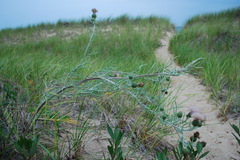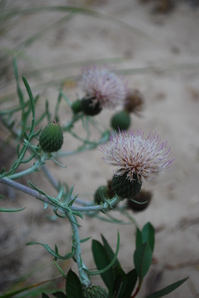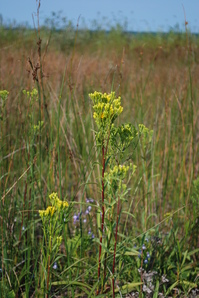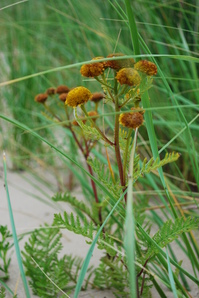
Pitcher's thistle (Cirsium pitcheri) in its dune habitat.
Rick Meader | Contributor
Hello again! Your roving native plant reporter is back from a great week spent up north, near Wilderness State Park. It’s great to go to a very different area and see some natives that are shared with us, and others that have never, naturally, seen the light of day in Washtenaw County. The hills were alive with common milkweed, swamp milkweed, wild bergamot, spikenard, Joe-Pye weed and boneset, to name a few, but the dunes were alive with Pitcher’s thistle, Houghton’s goldenrod, Lake Huron Tansy, marram grass and purple gerardia, to name a few. The dunes I visited were also alarmingly invaded by the invasives spotted knapweed and white clover, but we’ll focus on the positives and learn about a few natives that I would never, ever recommend for your gardens down here, but they are fun to find in the wild.

The bloom of a Pitcher's thistle (Cirsium pitcheri)
Rick Meader | Contributor
Pitcher’s thistle (
Cirsium pitcheri) is a cool plant discovered by Dr. Zina Pitcher, former regent of the University of Michigan. It’s a thistle, but it’s soft to the touch, not thorny. Its leaves are almost ghostly white and multi-fingered, like the grim reaper reaching out from beneath the sand, and its flowers are also white or light pink. It lives about 5-7 years, starting small, and gaining energy and size through its life, finally bursting forth in a blaze of white glory about 2-3 feet high, blooming with about 8-10 flowers per plant (in the plants I observed), and then dying, leaving only its seeds to carry on the proud tradition. The flowers are insect pollinated, with bees doing the heavy lifting.
This is a dune specialist, thriving on the barren, changing conditions of the blowing sand with adaptations such as a long taproot (up to 6’ long) to help it find water. It’s also a threatened species, occurring naturally along the shores and dunes of Lakes Huron, Michigan and Superior. Its common name is in reference to Zina Pitcher, an early regent of the University of Michigan, physician and mayor of Detroit. Wormwood (Artemisia caudata) is a plant with leaves that look a bit similar to Pitcher’s thistle, but its leaves are finer, and its form is more vertical, with a cluster of flowers standing at the top of its stalk. If you want to learn more about Pitcher’s thistle, here is the Fish and Wildlife Service fact sheet:

Houghton's goldenrod (Solidago houghtonii) sprouts up from a mini-dune on a Lake Michigan shoreline.
Rick Meader | Contributor
Houghton’s goldenrod (
Solidago houghtonii) is another dune- and beach-dweller, and a very pretty plant indeed. It was discovered and described in 1839 by Douglass Houghton in Mackinac County while on a geological survey. In appearance, it’s kind of a cross between stiff goldenrod (vertical in nature with flat-topped bright yellow flower heads) and showy goldenrod (a deep red stem). The plant itself is not terribly robust, mainly a single stalk rising to about 2 ½’-3’ tall. It’s native to Michigan, New York and Ontario and is blooming now. Like Pitcher’s thistle, it is also on the threatened species list due to its limited range, and the dangers it faces from shoreline developments and shoreline usage by humans. I took a long walk on Sturgeon Bay in Wilderness State Park and saw a great deal of this and the previously mentioned plants. Someday I hope to visit there in the spring to look for Michigan’s state flower, the dwarf lake iris. More information about Houghton’s goldenrod can be found
here:

The flowers of Lake Huron Tansy (Tanacetum huronense) are a bit past their prime.
Rick Meader | Contributor
Lake Huron Tansy (
Tanacetum huronense) is another dweller of the lake shores and dunes along the shores of northern Lake Huron and Lake Michigan and the southeast shores of Lake Superior. It has bright yellow flowers that has a daisy type flower in that it has a core of disk flowers and a ring of ray flowers that form the “petals” of the flower, but the petals are nowhere near as noticeable as the large “center”. The perennial plant grows to about 2-3’ tall, and has hairy, highly segmented leaves that appear almost fernlike, but this plant loves sun and the difficult conditions of a sunny foredune or the shifting sands of beaches and dunes. It spreads via seeds and rhizomes, and helps to stabilize dunes and beaches, although not to the same degree that beach grasses do. Like the previous two plants, Lake Huron Tansy is also threatened for the same reasons - beach and dune development and destructive use of those habitats, as well as invasion of those habitats by invasives such as spotted knapweed and baby’s breath. If you want to learn more about this plant, check out the Michigan Natural Features Inventory
fact sheet or the
fact sheet of the Wisconsin DNR.
One of the beauty of natives is that they make an area unique. Once I visited Taipei, Taiwan, and stayed in a very nice hotel, with beautiful landscaping. On closer inspection of the plants near the entrance, however, I saw that they were mostly impatiens and begonias, the same bedding plants used around here in many, many landscapes (including parts of mine, to be honest). They may actually be native over there, I don’t know, but I know they’re not native here, and are part of the homogenization of our landscape.
Using natives where they’re native helps to give a region a uniqueness that can be appreciated by human natives and visitors alike. As we discussed before, they also support native insect and bird life as well. And, as much as I would love to have a Pitcher’s thistle growing in my sandbox, I fought the urge to gather some seed and left it up there, where it is native and can continue to support the species.
So, I guess what I’m saying, choir, is enjoy the natives in an area where you visit, and enjoy them here, but don’t try to mix the two.
OK, I’m done. Blooming in my yard this week are brown-eyed susan, common evening primrose, green-headed coneflower, ironweed, Virgin’s bower, woodland sunflower and tall coreopsis. The asters and goldenrods are getting ready!
Enjoy nature, everyone!





